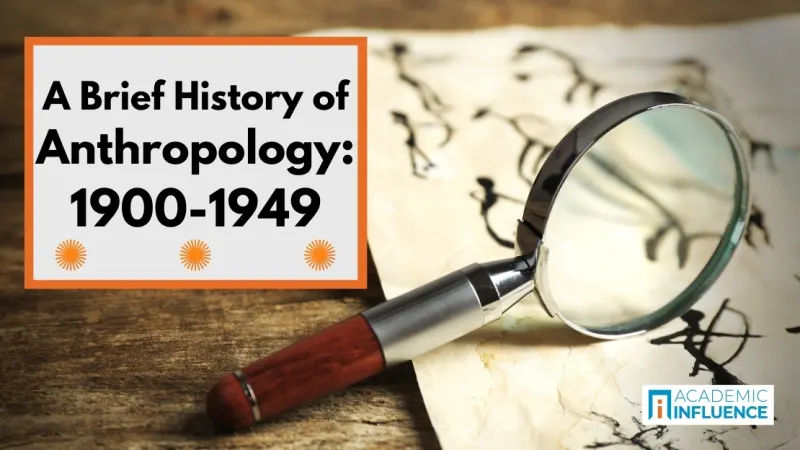A Brief History of Anthropology: 1900-1949

We explore the field of anthropology during the first half of the 20th century.
In the early 20th century, anthropology took shape as the discipline we mostly recognize today, coalescing into the study of four interconnected sub-fields: cultural, linguistic, archaeological, and physical anthropology. In particular, in the 1920s the hugely influential German-born American anthropologist Franz Boas regarded anthropology as a research discipline whose primary goal was the scientific study of different cultures. Cultural anthropologists were to use the scientific method to study present-day cultures; linguistic anthropologists studied how cultures use language; archaeologists concerned themselves with the study of ancient cultures and civilizations; physical anthropologists examined the link between biology and people living in a given culture.
Interested in exploring the field of anthropology as an undergraduate? Find out How to Major in Anthropology.
As a professor at Columbia University in New York City for nearly four decades, Boas also trained the next generation of anthropologists to carry the torch, with luminaries like Alfred Kroeber , Ruth Benedict, and Margaret Mead exerting a huge influence on the field of cultural anthropology. Benedict and Mead both gained prominence by performing now-famous field work in remote areas of the world, documenting and seeking to understand the culture of different peoples. One of Boas’s key points, which proved to be a major turning point for the field of anthropology, was his insistence that biological differences underdetermine, and therefore cannot in fact explain the differences we see between cultures. He thus promoted the study of culture as an end in itself, rather than a derived field from early Darwinian theories of biological change and origins. This proved seismic in shifting anthropology away from “hard” science in the 20th century.
Interested in earning an advanced degree in anthropology? Find out what you can do with a Master’s Degree in Anthropology?
In Europe in the early 20th century, a view known as functionalism dominated anthropology. Functionalism stemmed from another 19th century source—not Darwin but Durkheim. Émile Durkheim had argued that the real purpose of religious belief and practice in society was to provide for the smooth and proper functioning of the society (hence “functionalism).
Durkheim’s view that culture reflected strategy for function was taken up by British anthropologists in the 20th century, notably by Bronisław Malinowski and Alfred Radcliffe-Brown . In Britain, under Malinowski and Radcliffe-Brown, functionalism came to dominate anthropology in Europe by the 1930s. Functionalists sought to understand particular cultural institutions and their role in promoting the proper functioning of the society as a whole. This might include an exploration, for instance, of the “rite of passage,” in different cultures. This tradition, which typically features both ceremonial and practical elements in most cultures, is a symbolic and functional way of inducting youth into adult society. It thus greased the wheels of social function by inculcating values, attitudes and skills necessary for each generation which would eventually take up the reigns in a given society. Functionalism thus importantly shifted anthropological thinking from the evolutionary model, which implied the superiority of one culture over another, to models which devised and incorporated functional beliefs and practices.
Yet by the mid-20th century, Europe and eventually the United States had turned away from Darwinian and functionalist roots to embrace a new theory known as structuralism, after the French anthropologist Claude Lévi-Strauss . Levi-Strauss believed that culture–this seemingly fluent and amorphous set of beliefs and practices common to all human societies–actually emerged from more basic psychological or mental structures governing how humans conceptualize and make sense of their world (hence structuralism). Levi-Strauss pointed out that we naturally see things in terms of opposites: good versus evil, white versus black, etc. Such structures governing human thought inevitably give rise to culture, explaining how all cultures have commonalities even as particular practices and beliefs differ. Levi-Strauss’s infusion of psychology into the discipline would usher in more changes to the rapidly changing field of anthropology by the 1950s.
Find out which influencers have most contributed to advancing the field of anthropology over the last two decades with a look at The Most influential People in Anthropology, for the years 2000–2020.
And to find out which schools are driving the anthropology field forward today, check out The Most Influential Schools in Anthropology, for the years 2000–2020.
Or, read on to find out about the next stage in the history of the anthropology discipline.
For study starters, influential books, and much more, check out our full collection of study guides.
Or get tips on studying, student life, and much more with a look at our Student Resources.